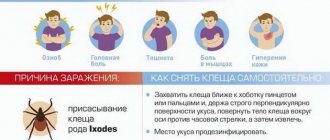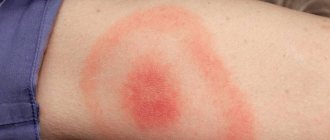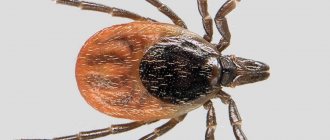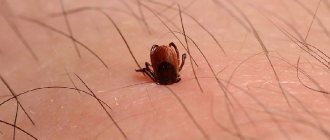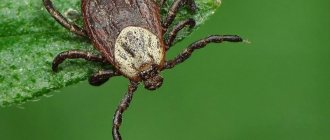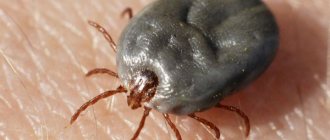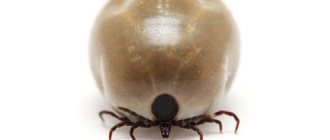The onset of warm days makes it possible to go out into nature, which can often be overshadowed by the discovery of a tick bite on the body. In the hotter seasons, this problem is especially relevant and every year parasites are found even in those regions where they had not previously been noticed.
The bite itself does not pose a danger to humans; the threat lies in the fact that the parasite can be a carrier of the causative agent of serious diseases, the consequences of which are not always correctable.
In order to protect yourself, it is important to know what a tick looks like under the skin and what the difference is between a sucking parasite.
Causes of tick bites in humans
Ticks are bloodsuckers, so they are just waiting to crawl onto someone and have a good meal.
And let him eat for himself, but bad luck - ticks carry dangerous diseases. If you are bitten by a sick bloodsucker, it can pass the disease on to you. Experienced tourists know where danger lurks, and we will try to remember too.
A tick bite can be earned in several ways:
- if you visit regions endemic for ticks, forests and parks (the most infectious ticks are in Siberia, the Volga region and the Urals);
- if you walk around in such regions in open clothes. The tick will easily crawl into a secluded place on your body and attach itself for several hours;
- if you communicate closely with animals (dogs, cats), who often carry ticks, or people: they can bring a bloodsucker on clothes, in a bouquet of flowers or on branches.
Let's say you are going to the forests in the Urals. Be sure to dress with as much skin coverage as possible, such as tucking pants into socks and sleeves into gloves. This will make it difficult for the tick to get on the skin. These bloodsuckers usually sit in the grass and cling to their legs.
Once on a person, ticks look for places with thin skin, so they are often found in the groin, on the lower back, in the armpits, behind the ears and on the neck, as well as in the hair on the head.
Danger to humans
These blood-sucking creatures pose a great threat to humans, as they can infect dangerous diseases. In this case, it does not matter at all whether it is found on the body, or whether it drank blood and fell off on its own; it is its bite that is dangerous. Therefore, it is very important to contact medical institutions when it is detected.
If you manage to save the insect, you can submit it for analysis, which will show whether this individual is infected. If you remove it from the body yourself, then you need to put it in a glass container along with a piece of damp cloth, which will not allow it to dry out. Analyzes are carried out with live insects, which allows you to obtain accurate results. If the parasite is dead, burst, or there is only a fragment of it, then research can be carried out, but the result will not be accurate.
In cases where you have not noticed the tick itself on your body, then symptoms appear, consult a doctor immediately. These parasites can transmit diseases such as encephalitis and Lyme disease.
Lyme disease
This disease is manifested by such symptoms as fever, headache, body aches, weakness, and a cough and runny nose may also appear. These symptoms are similar to a cold or even the flu, so a person may not think about having a dangerous infectious disease. The main sign that you definitely need to pay attention to is the appearance of a large red spot on the body, which has a clear outline.
This disease affects the nervous and lymphatic systems. It is very important to start treatment at an early stage, since brain activity suffers, memory may deteriorate, and disturbances in thinking processes occur. The facial nerves are also affected as they are damaged.
If the correct treatment is applied, the disease can be completely cured. In situations where treatment is not applied, complications occur, which in severe forms are not always amenable to treatment.
Tick-borne encephalitis
This disease is very dangerous with complications. Encephalitis manifests itself with the same symptoms as the previous illness, only there is no reaction in the form of a circle on the skin.
If left untreated, the nervous system is affected; this process can occur as early as a week after infection. The person experiences severe headaches and epileptic attacks may occur. Next, internal organs are damaged, the liver, kidneys, etc. are destroyed.
Regarding children, the disease poses an even greater danger for them, since children cannot correctly describe their condition and talk about their feelings, which for parents does not allow them to create a complete picture and correctly respond to the situation. It is very important after each walk in nature to pay maximum attention to examinations and, at the slightest suspicion, consult a doctor.
In addition to the above diseases, ticks also carry other dangerous infections, which include typhoid, ehrlichiosis, fever, tularemia, etc. The diseases are treatable, the main thing is to seek medical help in time, then you can avoid serious consequences.
Hemorrhagic fever
By the name of this pathological condition, one can understand that its main symptom is a sharp increase in temperature to extreme values (39...40°C). In addition, signs characteristic of viral diseases appear. When a blood test is performed, leukopenia and thrombocytopenia are often diagnosed based on changes in its composition. One of the main signs of hemorrhagic fever is a violation of the integrity of the walls of blood vessels.
As a result,
their permeability increases, which contributes to redness of the outer integument.
Hemorrhagic fever after a tick bite
Viral infections
Tick-borne encephalitis is one of the dangerous viral infections that affects the peripheral and central nervous systems.
At the onset of the disease, chills and fever begin, then damage to the meninges, fever, vomiting, drop in blood pressure, and arterial hypertension occur. Possible death.
Infection with encephalitis occurs when the parasite sucks blood . The male tick sucks blood for a short time - several hours. But the female stays on the skin for many days. The incubation period of the virus lasts 1-2 weeks. During this period, the affected person may not experience any symptoms.
Next, a fever appears, which lasts acutely and is characterized by a very high temperature - up to 40 degrees . Severe headaches, dizziness, hallucinations, and muscle pain appear. Vomiting and nausea are possible. Confusion and deafness often occur. Complications of the disease include paralysis of muscles and nerves.
The disease is treated by administering ready-made antibodies, which are obtained from the blood masses of donors. In the first hours after the bite, it is especially important to administer immunoglobulin. Treatment with antiviral drugs, ribonuclease and interferon is also used.
Ixodid tick-borne borreliosis (Lyme disease) is transmitted by ixodid ticks using saliva. The incubation period of the disease is 7-14 days.
Early symptoms of infections are fever, inflammation of joint tissues, erythema migrans, and elevated temperature. The disease affects the organs of vision, heart, blood vessels, and central nervous system. The course and outcome of the disease depends on timely access to doctors. Chronic borreliosis is especially difficult to treat.
- supportive and anti-inflammatory therapy;
- taking antibiotics;
- consumption of vitamins;
- prescription of immunomodulators.
Medicines are prescribed that relieve intoxication and regulate the functioning of internal organs.
Tick-borne typhus is another disease transmitted by insects. The disease is especially often caused by taiga ticks in Siberian regions.
The incubation period of the disease is 4-5 days. Further, the disease manifests itself as muscle pain, fever, and tissue necrosis. The disease has a favorable prognosis. In most cases, Tetracycline and antiviral drugs are prescribed for treatment.
Microbial infections
Ehrlichiosis is an infection transmitted through the saliva of a parasite. A focal infection is caused when an insect attaches itself to a person.
If you find a mark from a tick bite, you must go to the hospital. When bitten, Ehrlichia penetrates the bloodstream and causes the development of an inflammatory process.
Monocytic ehrlichiosis is characterized by:
- abdominal pain;
- damage to the central nervous system;
- nausea;
- vomit;
- hyperesthesia;
- chills;
- catarrhal symptoms;
- feverish condition.
In case of illness, it is important to periodically check the blood picture - complications such as leukopenia, anemia, lymphocytopenia are possible . Whole blood and serum are taken for research. Treatment of the disease is prescribed even before laboratory results are obtained. The main drug in therapy is Doxycycline.
Ixodid ticks also cause granulocytic anaplasmosis. The disease is caused by an intracellular parasite carried by ticks. Together with the insect's saliva, anaplasmas enter the bloodstream and infect neutrophils.
As a result, various inflammations develop in the internal organs. The acute course of the disease is characterized by severe kidney damage - proteinuria develops. Treatment comes down to eliminating the pathogen and symptoms of the disease.
Rickettsial infections
Mountain fever is an infection caused by an Ixodid tick bite. The causative agent is rickettsia bacteria. The disease is expressed in general intoxication and fever.
Special signs of the disease are:
- microinfarction;
- pathological changes in blood vessels;
- necrosis of cellular endothelium;
- blood clot formation;
- inflammatory process of arterioles.
As the infection progresses, an extensive measles rash appears. In the severe stage, the disease takes on a hemorrhagic form. The disease is accompanied by an inflammatory process in the kidneys and interstitial myocarditis.
Rocky Mountain fever is the most severe rickettsial infection.
At the onset of the disease, the following begins:
- nosebleeds;
- lymph nodes become inflamed;
- joints are affected.
There is headache and prostration of consciousness. A characteristic sign of the disease is damage to the central nervous system. Pneumonia and gangrene of the extremities may occur.
The treatment of mountain fever involves antibiotic therapy and drug relief of hemorrhagic changes and thrombosis.
Medications to normalize the temperature and antibiotics Doxycycline, Levomycetin, Tetracycline are prescribed. Heparin is administered intravenously using a dropper. Treatment is carried out in a hospital inpatient unit.
Coxiellosis (Q fever) is a rickettsial disease caused by tick bites. The causative agent of the disease can be found in dry tick feces. A person becomes infected with a fever from a tick bite. The incubation period lasts up to 17-19 days.
Then the symptoms begin:
- muscle pain;
- wheezing in the bronchi;
- bradycardia;
- heat;
- headache;
- eye pain.
Treatment boils down to eliminating the pathogen with antiviral therapy and eliminating symptoms. Recovery with proper treatment occurs after 2-4 weeks. However, in some cases, a relapse of the disease is possible.
Protozoal infection
The tick is a carrier of protozoa, bacteria, and viruses, so the appearance of a protozoal infection after a bite is not uncommon. The intestinal form of infection affects the entire gastrointestinal tract. Very often, with a mild course of the disease, a person does not pay attention to periodic attacks of loose stools and abdominal pain. No intoxication or increase in temperature is observed.
In severe cases, the stool may contain blood streaks and be jelly-like. Extraintestinal forms of the disease are manifested by damage to the liver, lungs, and brain.
Treatment of the pathology includes the use of Doxycycline, antibiotics, Etoftamide, Chloroquine. The prescription of medications depends on the form of the disease.
To prevent diseases, it is important to follow preventive measures when visiting the park area. There is a wide variety of parasite species in nature. It is important not to leave exposed areas of the body without clothing when walking in the forest, and also, if possible, apply insect repellents to the body.
What does a tick bite look like on a person?
After going outdoors, examine your skin, and where you can’t, let your friends check. Finding a tick bite is especially easy if the tick bite is still in place. As it becomes saturated, it gets fatter, so it is difficult to view it. And if he has already eaten and fallen off, what other signs are there of a tick bite in a person?
- You can tell that you have been bitten by a tick by a red round spot on the surface of the skin. Rarely is the shape oval or with uneven edges, explains therapist Olga Fedorenko , who runs the Instagram channel doc.fedorenko. — Additional signs of a tick bite in a person may include swelling, rash and itching. In this case, there is usually no pain.
Itching and other signs of a tick bite in humans occur in response to the bloodsucker’s saliva getting into the wound. Often such symptoms are observed in allergy sufferers, children, the elderly and those whose immunity is weakened. In this case, the allergic reaction to the bite can be quite severe, but its symptoms can be relieved with the help of antihistamines.
Ticks in Moscow
Risk factors
As mentioned above, what is unpleasant is not the presence of a subcutaneous mite as such - in itself it cannot harm a healthy person - but demodicosis, which is caused by a mite. If the body is weakened and there are additional risk factors, the tick can settle in the skin for a long time and cause considerable mental and physical damage to its “breadwinner”. Risk factors include:
- dysfunction of the sebaceous glands, changes in the composition of sebum, vascular changes;
- some skin diseases (rosacea, acne, seborrhea);
- long-term use of hormonal corticosteroid ointments;
- adolescence;
- pregnancy;
- stress.
Unfortunately, non-specialists react with unacceptable ease to the appearance of acne on the face and body. The appearance of such problems is attributed to age and ordinary acne, which sooner or later should disappear on their own. We have to disappoint you: demodicosis caused by subcutaneous mites will not go away on its own. The disease can travel from one area of the skin to another, existing for years and ruining the life of its “donor”.
IMPORTANT:
squeezing out acne when infected with a subcutaneous mite only leads to an exacerbation of the infection, since during this process the mites are pressed into healthy areas of the skin and infect them.
Make an appointment
First aid after a tick bite
If you find a tick attached to your body, the first thing to do is remove it. It is best to entrust this matter to specialists: go to the emergency room at the clinic. If this is not possible, we pull out the tick ourselves, the main thing is not to let its head come off and remain in the wound. This is not so easy, because the tick holds on very tightly. Under no circumstances should you crush it - the danger of contracting some disease will only increase.
Before removing the tick, use alcohol or chlorhexidine to treat the tick bite site on a person. It would be nice if you have special medical tweezers on hand to remove the arachnid, but a self-made loop or a “vacuum” syringe will do.
Treatment
Only a specialist can prescribe complete and competent treatment. The first test for demodicosis may show a negative result. The larvae and subcutaneous mites themselves are quite difficult to identify, so it is better to carry out the analysis several times for an accurate result.
Means necessary for both treatment and prevention:
- Vitamin preparations.
- Antiparasitic drugs.
- Immunomodulatory agents.
Medicines often prescribed by doctors for the treatment of demodicosis:
- Ointments: sulfuric, clindamycin, with metronidazole.
Sulfur ointment also shows effectiveness in the treatment of scabies in children.
- Klion.
- Metrogil.
- Amitrosole.
- Alcohol-based products.
How to pull it out
The signs of a tick bite on a person have been sorted out, the bite itself has been found, now the bloodsucker needs to be pulled out.
- We treat hands, tweezers and the bite site with alcohol or chlorhexidine.
- We grab the insect with tweezers as close as possible to its head and to your skin, respectively.
- Slowly turn the tick approximately 180 degrees, perpendicular to the skin, making unscrewing movements. To remove the bloodsucker, more turns may be required, the main thing is not to rush or jerk.
- When the tick is removed, treat the bite site with alcohol or any other analogue again.
- Place the removed tick in a small glass container and close tightly.
- Take the tick to a laboratory to find out if it carried any diseases.
“If you don’t have tweezers, use a woolen thread or a lasso handle,” advises therapist Olga Fedorenko . “You can also cut off the top of the syringe, apply it to the bite site and pull out the tick under pressure.
How to get rid of a tick
Reviews from those who have been bitten by ticks
Ticks carry many diseases. We have all been vaccinated against encephalitis since our student days, no one got sick. But an employee caught Lyme disease a couple of years ago. The first symptoms are fever and headache, aches throughout the body. I was treated in St. Petersburg, but after a few months everything passed without visible consequences.
Alex
https://otvet.mail.ru/question/37291176
He bit me many times, we have a dacha in the forest. We managed on our own. Extracted using sunflower oil. I took antibiotics. And a young woman of a friend died, she was treated for a long time for everything... but it turned out to be encephalitis. It is necessary to submit the tick for analysis.
Elena Sorokun
https://otvet.mail.ru/question/37291176
He clung to me a year ago - in the botanical garden in Kyiv. I walked with him for a day, only the next morning the guy discovered it (on the back of my hand - I wouldn’t have seen it myself). We went to the hospital (and it was still Sunday) - it was closed, then to another. Then they pulled this tick out (it didn’t hurt at all, by the way), and immediately into the trash. And when the guy asked if they would check the tick for encephalitis, the doctor made such a face as if we had offered to take this tick to America for testing, honestly. But, thank God, it turned out okay.
Anelissa
https://otvet.mail.ru/question/76487449
In the ambulance they advise you to pull out the tick with tweezers, take it closer to the skin with tweezers and carefully twist it, in which direction to turn it - I don’t remember, whether clockwise or counterclockwise. You can try this and that, and of course, get him checked for encephalitis. I don’t recommend using oil, it doesn’t come out, it just dies, it’s been tested more than once.
Princess Frog
https://otvet.mail.ru/question/24820727
A tick bite is dangerous, even if the parasite is removed promptly and correctly. Local reactions do not pose a direct threat to the life of the victim, but can result in long-term discomfort. You need to examine the wound daily until complete healing. If there is no positive trend and the condition worsens, visit an infectious disease specialist.
What to process
First of all, remember that you should not lubricate the tick with oil or cream in the hope that it will come out on its own. Rely on yourself better.
You can treat a tick bite on a person with soap and water, and then it would be a good idea to walk over it with an antiseptic. You can use alcohol or chlorhexidine, which is sold at any pharmacy. Alternatively, 5% iodine, cologne, or any disinfectant that is at hand will do.
If the tick's proboscis breaks and remains in the skin, do not try to pick it out; it will come out on its own after some time.
What then is possible?
To begin with, we should say what is needed - a dietary regimen during and after treatment. What about cosmetic procedures? Some of them are a real salvation in the fight against demodicosis. They help restore infected areas of the skin:
- cryotherapy - cold exposure, causing a sharp spasm of blood vessels followed by persistent dilation; result - peripheral blood supply is enhanced, skin nutrition is improved, metabolic processes are accelerated, the immune system is activated, and the skin's resistance to stress increases;
- mesotherapy - carried out during the period of remission, this is an injection procedure, the essence of which is the delivery of restorative substances contained in the preparations / cocktails to the tissues;
- plasma therapy - carried out during the period of remission, this is the introduction of purified and platelet-rich blood plasma of the patient into the affected areas of the skin; As a result, skin immunity is stimulated, and regeneration processes are launched at the cellular level.
Each of the procedures described above is prescribed in a course; to achieve a sustainable effect, on average, 5–6 procedures are required, which are carried out every 7 days.
Where to contact
If the goal is to remove the bloodsucker, you can go to the nearest emergency room. Specialists will carefully remove the tick, and all you have to do is show the “pet” to the laboratory workers. To remove the mite, place it in a clean container; test tubes, jars, and vials will do. It is better if this container is humid. To create comfortable conditions for the tick, place there, for example, a napkin moistened with water. In this form, the tick must be delivered to the laboratory within two days.
Each region has its own organizations responsible for research of this kind. Addresses of laboratories can be found in Rospotrebnadzor. Typically, research is carried out by specialists from regional “Centers for Hygiene and Epidemiology”. They will check your tick and give you the results - sick/not sick and what it is sick with. This usually takes one or two days.
If you don't want to or can't test a tick for a particular disease, you can test yourself. Most often, ticks transmit encephalitis and borreliosis. You can get tested for these diseases in infectious diseases hospitals, virology and commercial laboratories.
It will be more convenient for you if the chosen clinic tests for both diseases at once.
Prevention
Prevention of diseases carried by ticks comes down to avoiding bites; in rare cases, vaccination will help protect you.
How to prevent ticks from biting you?
When going outdoors during tick season, the following preventive measures are necessary:
- use clothes with long sleeves and trousers that cover as much area of the body as possible, it is better if the clothes are light in color,
- wear hats,
- carefully inspect your body and clothes after a walk, comb your hair with a fine comb,
- also inspect your pets if they are walking outside (dogs often bring ticks into the house on their fur),
- use repellent before walking in the forest,
- do not tear off branches and try not to touch them, so beware of tall grass and bushes, stay in the middle of the path.
Photo: rawpixel.com / freepik.com
The effectiveness of vaccination, is it worth it?
You can protect yourself from tick-borne encephalitis and tularemia by getting vaccinated.
Vaccination against tick-borne encephalitis
In Russia, vaccination against tick-borne encephalitis is indicated for residents of areas where encephalitis is endemic. You should receive a course of vaccinations in advance, at least 2 weeks before the start of the tick season. The vaccination regimen includes two doses of the drug with an interval of 1-3 months between doses and revaccination after a year. The completed course guarantees a stable immune response for 3 years.
If you missed the vaccination dates or unexpectedly went to a dangerous area, you can take an emergency course of 2 doses of the vaccine with an interval of 2 weeks. Revaccination will also need to be done after a year.
According to studies conducted in Russia, the frequency of development of stable immunity during vaccination according to the traditional scheme is up to 91%, and according to the emergency scheme – 88%.
Important! Vaccination against tick-borne encephalitis is the most effective measure to prevent this disease. Anyone who is in an area with an increased risk of contracting encephalitis or plans to stay in such a place should be vaccinated.
Vaccination against tularemia
In our country, people from foci of infection and workers in hazardous professions who have a high risk of infection are vaccinated against tularemia (for example, agricultural workers). Vaccination is allowed starting from 7 years of age.
For protection, one dose of a live vaccine administered subcutaneously or intradermally is sufficient. Revaccination is carried out every 5 years. The tularemia vaccine can significantly reduce the incidence of the disease and alleviate the symptoms of the disease.
Important! Before vaccination, a doctor’s examination is necessary; the drugs have contraindications for administration. After vaccination, remain under the supervision of a specialist for at least half an hour in case of a sudden negative reaction.
Encephalitis insurance. Is it worth doing?
If you are not vaccinated and at the same time, due to the nature of your work, you are often in places where ticks live, it is advisable to conclude a voluntary health insurance contract in advance against tick-borne encephalitis. This will allow you not to think about the cost of treating this serious disease in the future.
The cost of the policy usually does not exceed 150-300 rubles. If you insure yourself and get sick, you will not be able to claim cash payments, but the insurance company will have to pay the costs of treatment and rehabilitation. The insured amount can range from 50 thousand to 1 million rubles, depending on the insurance company, insurance program and region. It is within these funds that you will be provided with the necessary medical care.
Typically it includes:
- examination of the victim and removal of the tick,
- laboratory testing of ticks for the presence of viruses,
- administration of immunoglobulin if indicated,
- hospitalization and treatment if the disease occurs,
- restorative therapy.
Popular questions and answers
In which regions is there a high risk of contracting encephalitis or borreliosis from a tick?
The majority of bites from infected ticks are recorded in the Urals, Siberia, the Far East and the regions of the Northwestern Federal District. When hiking in these regions, you need to be extremely careful, and even better, get vaccinated in advance. You need to understand that infected ticks can also be found in other parts of Russia; residents of all regions of the country seek medical help because of their bites every year.
Is it true that ticks live on trees?
In fact, ticks are usually located in tall grass, about 30 cm from the ground. This makes it easier for them to cling to the legs of those walking by. For the same reason, ticks especially like to be located near paths; they sense where people and animals most often walk. Sometimes ticks climb onto bushes and lower branches of trees.
Where do ticks usually bite?
A tick bite on a person is usually located in places where the skin is thin; it is easier for the tick to bite through it. They stick in the groin, on the stomach and lower back, in the armpits, on the chest, behind the ears, on the neck and on the scalp. A tick bite on a person looks like a red round spot, and the tick itself, as a rule, is located on it, plunging its proboscis under the skin.
Is it possible to fill a tick with oil or alcohol?
A common misconception is that if you pour oil, gasoline, alcohol, or grease onto a tick, it will suffocate and fall off on its own. Nothing of the kind, with your manipulations you can only spur the tick to stick tighter. It is better to treat the tick bite with antiseptics, for example, alcohol or vodka, just water and soap will do, and then pull it out with tweezers.
What to do if it is not possible to take a tick for analysis?
Observe the condition of the injured person. If the inflammation at the site of the tick bite disappears within 1-2 days, the likelihood of developing any disease is considered minimal. If the swelling remains or worsens, go to the doctor. It will not be superfluous to constantly change the temperature of the victim. If it increases within 10 days of the bite, there is a serious risk of developing an infection, so do not delay visiting a doctor.
What if after a bite you start taking antibiotics just in case?
Such a safety net is pointless and dangerous. Firstly, not every tick is infected, secondly, not every sick tick will transmit this or that ailment to you, thirdly, it is no coincidence that antibiotics are given according to prescriptions; without the proper knowledge you will not select the optimal drug and dosage. But the worst thing is that delay due to antibiotics can lead to serious problems.
Types of ticks
There are about 54 thousand species of ticks in nature. All of them belong to the arachnid class of arthropods, but only the most dangerous of them feed on the blood of humans, birds and animals. They resemble small bugs, about 3-4 mm long, and have 4 legs with small hooks that help them climb in search of the bite site. Pathogens enter the human blood through the proboscis. The parasite has a well-developed sense of smell, thanks to which it senses the victim at a distance of up to 10 m by the heat emanating from the body and the smell of sweat.
The most famous types of ticks in our region are:
- ixodid (the most dangerous, a carrier of tick-borne encephalitis, lives on the lower branches of trees, low bushes, grass stems, loves shade and moisture, feeds on blood);
- subcutaneous (a source of demodicosis, can live on the human body for many years, feeds on dead cells of the epidermis, becomes active during a period of weakening of a person’s immunity, penetrating deep into the skin, causing burning and itching);
- argas (its habitat is cracks in buildings, bird nests, caves, attacks in the dark, has a painful bite, unlike the bite of the ixodid tick);
- bedding (lives in down pillows, mattresses, blankets, feeds on dead epidermal cells, invisible to the human eye).
Of all the listed species, ixodid ticks are the most dangerous.
Of these, only about 20% are carriers of such serious infectious diseases as:
- tick-borne encephalitis;
- borreliosis or Lyme disease;
- hemorrhagic fever;
- typhus.
What can be the consequences after a tick bite?
Just because a tick was not a carrier of any infection does not mean that its bite is harmless.
— If you do not seek medical help in time, you may encounter various consequences of such a bite. Firstly, suppuration may occur at the site of the tick bite. Secondly, allergies of various kinds and edema (Quincke's edema) are possible. The consequences can be very serious, including paralysis, respiratory arrest, cessation of brain activity and death, explains general practitioner Olga Fedorenko.
Why do ticks need blood?
In order for the female to lay eggs, she needs protein contained in the blood. An insect can suck blood from several minutes to several hours. A hungry ixodid tick weighs 3-15 mg, and a engorged tick weighs 200-1200 mg. At one time, a tick can suck up to 1000 mg of blood.
The size of a hungry tick does not exceed 4 mm, but a saturated one can increase in size up to 1-2 cm. After a bite, the tick does not die like a bee, but continues to develop and multiply.
If a tick simply crawls across the body, then it is impossible to become infected from it. Infection occurs when pathogens enter the bloodstream with the insect's saliva. If a tick is found on clothing, it should be shaken off as quickly as possible, but not crushed.
How dangerous is a tick bite?
In itself, a tick bite on a person does not pose a serious danger; the main risk is the infections that the arachnid can reward its victim. Most of these infections respond well to treatment, but only in the early stages. That's why it's so important to diagnose them as soon as possible. It’s good if you still have the same tick, because if it is infected, the doctor will be able to take preventive measures. It will be possible to find out whether you are infected only two weeks after the bite; only then will antibodies to viruses appear in the blood, and they serve as a marker of the disease.
— The tick is examined by PCR for six infectious diseases. If an infection is found in it, emergency prevention is carried out. For encephalitis - the introduction of immunoglobulin, for borreliosis - a course of antibiotics, explains general practitioner Olga Fedorenko . - You also need to donate blood for tests: for encephalitis and borreliosis - no earlier than 10 days after the bite.
If you catch the disease at an early stage, there is every chance of a successful recovery, but if you miss the moment, you can expect serious complications, the worst of which is death.
Characteristic symptoms of a bite
Attention!
If you notice the slightest symptoms, you should immediately consult a doctor. A tick bite is determined not only visually. If the insect has been infected, symptoms may appear within 2-4 hours after the bite:
- chills;
- feeling of aching in joints and muscles;
- temperature increase;
- drowsiness;
- fear of light.
For people with allergies, the following are added:
- nausea, vomiting;
- dizziness;
- chills;
- swelling;
- lack of coordination.
One of the main signs that a tick is infected is an increase in body temperature to 38-39°C. This can happen either a few hours after the bite or 7-10 days (average incubation period) after it.
Both the table and the house
Having clung to the host, ticks actively search for a suitable place to attach, preferably where it is more difficult for the host to get rid of them, for example, on the ears and head of rodents. On hedgehogs with their spines, mites are more evenly distributed, but on primates there are practically no mites. In regions with a dry and hot climate, ticks more often stick to the lower part of the body, protected from the sun. They can even be found in the mouths of elephants and in the nostrils of hippos and camels.
Ticks attach themselves to people in a variety of places: in the armpits, less often on the chest, abdomen, arms, buttocks and legs, as well as on the head, especially in children.
Ticks attach to the host's skin with their mouth parts, cut through it and use their proboscis to suck out blood, inflammatory infiltrate and tissue dissolution products, alternating this process with the introduction of saliva into the wound.
A sucked ixodid tick works like a well-oiled pump: per minute it makes from 2 to 60 acts of suction, strictly separated by acts of injecting saliva. Left
- an adult female ixodid tick feeding on a horse (after Estrada-Pena et al., 2017).
On the right
is the “head” of the taiga tick (view from the dorsal side). Scanning electron microscope. Photo by S. Tkachev (IBFM SB RAS, Novosibirsk)
Ixodid ticks feed slowly: larvae feed for 3–5 days, females for 5–15 days. During feeding, their body weight increases by one or two orders of magnitude: females of the largest species can absorb up to 8–10 ml of blood!
After finishing feeding, the larvae and nymphs fall away from the host and molt, moving to the next stage of development. In adult ticks, feeding is associated with reproduction. Partners, as a rule, meet on their host - hungry male and female ticks are not able to mate, with the exception of ticks of the genus Ixodes
. The male can remain on the host for several months and during this time fertilize several dozen females. The female mates only once, after which she quickly gains weight, falls away from the owner and after some time (from several days to months) lays eggs (from 800 to 20,000 depending on the species), after which she dies (Balashov, 1998; Biology of Ticks, 2014).
In most cases, the development of ixodid ticks occurs with a change of host at each stage of the life cycle. Their feeders are birds, reptiles and, first of all, mammals, especially rodents. Thus, the taiga tick parasitizes approximately 170 species of birds, 100 species of mammals and several species of reptiles. As a rule, small animals moving in the lower tiers are attacked by larvae and nymphs, and large animals are attacked by adult ticks (Balashov, 1998; Biology of Ticks, 2014).
The life cycle of ticks is complex. The eggs laid by the female hatch into larvae (still six-legged), which after molting turn into nymphs, and the nymphs into adults, called adults. The duration of the life cycle for different types of ixodid ticks can range from one to six or more seasons (years). At each stage of the cycle, the tick must once feed on blood, with the larva, nymph and adult feeding on different animal hosts. The larva drinks the blood of a small animal (rodent or bird). The nymph must find and attack a larger animal (squirrel, hedgehog, hare). The adult tick feeds on other, even larger animals, such as elk or deer. However, some species of ticks have adapted to carry out a full development cycle on one host animal, which is left only by the female who has drunk blood
